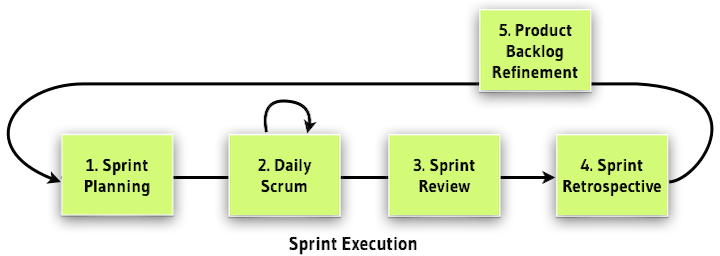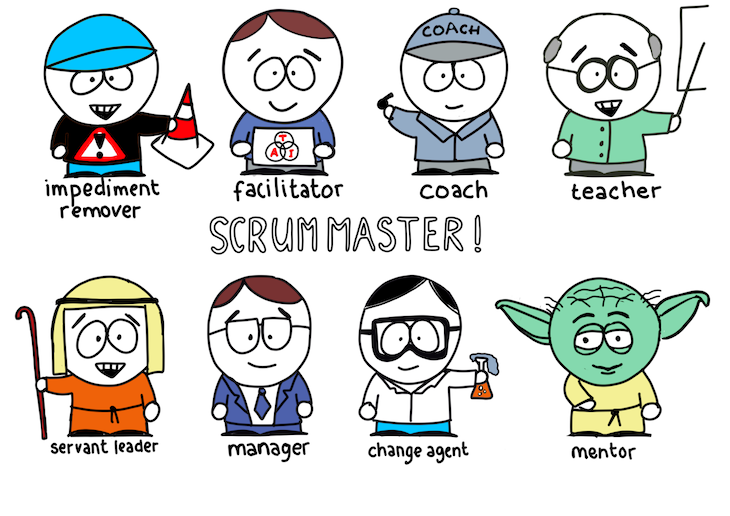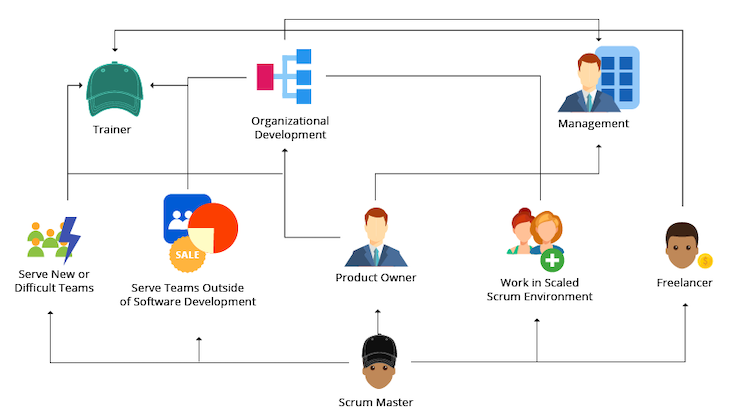In this guide, we’ll define the role of the scrum master. We’ll break down the scrum master’s responsibilities, describe this person’s relationship with the other scrum roles (product owner and scrum team), and offer tips, resources, and certifications to explore if you’re looking to become a scrum master.
Table of contents
- What is scrum?
- What is a scrum master?
- What does a scrum master do?
- What is in a scrum master job description?
- How to become a scrum master
What is scrum?
Before we get into the role of scrum master, we should clarify what we mean by scrum. You can’t understand how to be a master of something without knowing what that something is!
Scrum takes its name from rugby, in which a mini-team of players (known as a scrum) huddles together to push the opponent and take control of the ball.
In agile product development, scrum describes a framework that helps huddled teams work together. Scrum promotes close collaboration, focused attention, and continuous improvement to push through development and take control of product delivery.

What is a scrum master?
The Scrum Guide, which was written by scrum’s co-creators Ken Schwaber and Jeff Sutherland, describes the scrum framework and three specific roles therein: the product owner, scrum team, and scrum master.
The scrum master has some specific activities to perform within the scrum team, but they fall under the basic remit of coaching the team to work within the scrum framework and ensure that the team can keep functioning, making them accountable for the effectiveness of the team.
Therefore, if your organization wants to use scrum as its product delivery framework, it will need to find someone dedicated to the role of scrum master to ensure the team remains effective.
What does a scrum master do?
The scrum master, as the name implies, is there to lead the team toward success. As such, they also lead many of the scrum ceremonies, such as daily scrum meetings, backlog refinement sessions, and sprint retrospectives. This involves collaborating and communicating with team members, pushing for clarity, and developing an attitude of openness and learning.

When it comes to the day-to-day activities of a scrum master, what they do often depends on who they are working with. The scrum master’s relationship with a given role may be very different from their relationship with a different role or department.
The scrum master and the product owner
Product owners are responsible for defining the product goal and prioritizing the backlog items that are being worked on within the sprint. As such, their relationship with the scrum master is key to the scrum team’s success.
The scrum master supports the product owner by sharing this vision of product success and helping to communicate the requirements of all backlog items to the scrum team.
For example, if the scrum team isn’t clear on what a particular user story means or has a question about the best possible solution to a particular problem, the scrum master can offer advice and clarify potential approaches.
Together, the scrum master and product owner have the power to make the scrum team a roaring success or an immense failure. Therefore, their relationship is key.
The scrum master and the scrum team
The scrum team’s responsibility is to complete the user stories selected for the sprint and to deliver on the sprint goal. The scrum master is essential in facilitating this success.
The scrum master is in a position to coach the team on how to work within the scrum framework. They help curate the work included in the sprint and ensure that the expectations and desired end result are clear to all stakeholders.
Put simply, the scrum master’s job is to remove any impediments that threaten the team’s ability to deliver on the sprint goals in a timely manner.
For example, if the goal is to deliver a new homepage image carousel, it would be the scrum master’s job to push the design team to deliver the images to be used in the carousel. This could involve speaking to the designer to get the image files, the design manager to sign off the design, and/or the content team to confirm the caption copy. Whatever it takes to help the scrum team stay on track and on deadline.
The scrum master and the business
How does the scrum master work with the rest of the business? The interactions are similar to those we’ve already looked at with product owners and the scrum team. The difference is that they’re focused outside of the actual team.
The scrum master can take on the role of an educator, helping the business to understand the scrum framework, its benefits, and its ways of working. The more the business understands how work is delivered, the more likely it is to work within the framework themselves — which will only improve the company’s ability to provide relevant KPIs, adapt to changing requirements, etc. when working interdepartmentally.
The scrum master is also responsible for removing any barriers to progress for various stakeholders throughout the business, which is why the role requires a broad range of stakeholder management skills.
What is in a scrum master job description?
If we were to write a scrum master job description based on the responsibilities described above, we’d end up with something like the below.
The scrum master is expected to:
- Manage the scope of work to be done within the available time frame
- Lead the sprint ceremonies, such as the daily scrum and sprint retrospectives
- Work with the product owner to define the work to be done
- Remove conflicts and impediments to success
- Keep the scrum team focused on delivering the sprint goals
- Be the primary communicator within and outside of the scrum team
- Coach the scrum team as well as the rest of the business on the scrum framework
As for the skills required to be a scrum master, a qualified candidate would be someone who is:
- Organized and focused
- An exceptional communicator with good interpersonal skills
- Experienced in stakeholder management
- A natural problem solver
- Knowledgeable of the scrum framework and its roles, processes, and ceremonies
- Well-versed in the technologies used by the team
How to become a scrum master
A number of roles provide an ideal background for those seeking to become a scrum master, including product owner, but most scrum masters typically start in some form of project manager role.
These problem solving, people-centric jobs require skills that fit neatly within a focused scrum team. However, if you’re not currently in one of these roles, there are lots of resources you can turn to for information about how to become a scrum master.

A great starting point is Scrum.org, the official home of the scrum framework. This site is full of information about the scrum master role and its involvement with the framework. It also gives you access to some open assessments where you can test your current knowledge levels.
Scrum master certifications
Providers such as Scrum Alliance, Project Management Institute, and Scrum Inc offer accredited scrum master certifications. There are many other product management certification programs out there that do the same.
Types of scrum master certifications include:
- Certified Scrum Master (CSM), the core level, which usually involves a two-day course
- Professional Scrum Master (PSM), the next level up from CSM
- SAFe 4.0 Scrum Master (SSM), for use within organizations that follow SAFe
When evaluating scrum master certification providers, you should approach it in the same way you would when choosing a product management certification. How will your competency be evaluated? What is the teaching and assessment process? Do you need to have any prior experience to sit in on the course? How much does it cost?
Transitioning into a scrum master career
As with many careers, there may be opportunities to transition into the scrum master role within your existing organization. This is especially true for roles that work in close collaboration with the scrum teams and for candidates who already possess the requisite skills as described above.
For example, perhaps you’re a developer on the scrum team and you enjoy managing activities, solving problems, and working closely with others. Maybe your a product owner who loves coaching others on the ways of scrum.
In either case, your closeness to the existing scrum master and experience with the team could put you in good stead when a new opportunity arises.
Scrum master can be a very rewarding role, so if it sounds like it might be for you, I’d encourage you to give it a go.
The post What is a scrum master? Job description, certifications, and more appeared first on LogRocket Blog.
from LogRocket Blog https://ift.tt/8Icdah7
via Read more



